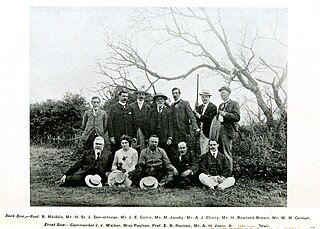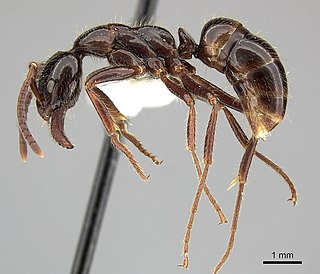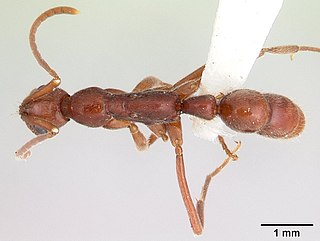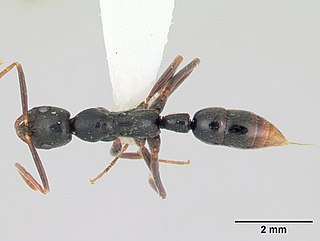
Horace St. John Kelly Donisthorpe was an eccentric British myrmecologist and coleopterist, memorable in part for his enthusiastic championing of the renaming of the genus Lasius after him as Donisthorpea, and for his many claims of discovering new species of beetles and ants.

Ponerinae, the ponerine ants, is a subfamily of ants in the Poneromorph subfamilies group, with about 1,600 species in 47 extant genera, including Dinoponera gigantea - one of the world's largest species of ant. Mated workers have replaced the queen as the functional egg-layers in several species of ponerine ants. In such queenless species, the reproductive status of workers can only be determined through ovarian dissections.

The wildlife of Cambodia is very diverse with at least 162 mammal species, 600 bird species, 176 reptile species, 900 freshwater fish species, 670 invertebrate species, and more than 3000 plant species. A single protected area, Keo Seima Wildlife Sanctuary, is known to support more than 950 total species, including 75 species that are listed as globally threatened on the IUCN Red List. An unknown amount of species remains to be described by science, especially the insect group of butterflies and moths, collectively known as lepidopterans.

Leptogenys is a genus of ants in the subfamily Ponerinae. Leptogenys is the most diverse ponerine ant genus in the world; it is widespread throughout tropical and subtropical regions and there are over 260 extant species described. Most species have ergatoid queens, and many have falcate, bowed mandibles and are specialists on isopod prey.

Ponerini is a tribe of Ponerinae ants with 46 genera and 6 extinct genera.

Leptogenys diminuta is a species of ant of the subfamily Ponerinae. Twelve subspecies are recognized.
Leptogenys exudans is a species of ant of the subfamily Ponerinae. It is found in Sri Lanka.
Leptogenys hysterica, is a species of ant of the subfamily Ponerinae. It is found in Borneo, India, Sri Lanka, and Thailand.
Leptogenys meritans, is a species of ant of the subfamily Ponerinae. It is found in Sri Lanka.

Leptogenys processionalis, is a species of ant of the subfamily Ponerinae.
Leptogenys pruinosa, is a species of ant of the subfamily Ponerinae. It is found in Sri Lanka, and Philippines.
Leptogenys peuqueti is a species of ant of the subfamily Ponerinae. It is found in India, Sri Lanka, China, Vietnam, and Philippines.
Leptogenys yerburyi is a species of ant of the subfamily Ponerinae. It is found in Sri Lanka, and China.

Messelepone is an extinct genus of ants in the formicid subfamily Ponerinae described from fossils found in Europe. M. leptogenoides is the only species assigned to the genus, which is one of several Lutetian Ponerinae genera.

Leptogenys manni is a species of ant in the family Formicidae.

Leptogenys elongata is a species of ant in the family Formicidae.









